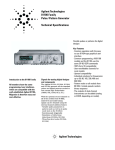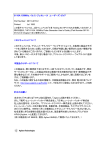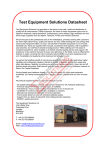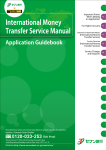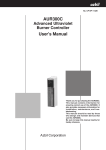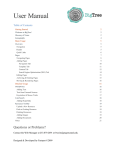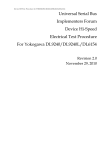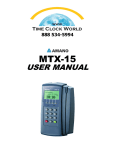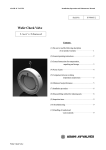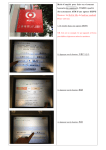Download Documentazione allegata
Transcript
Agilent Technologies 8110A 150 MHz Pulse Generator Technical Specifications Flexible pulses or patterns for digital designs Key Features · 150 MHz Timing · 2 ns Variable Transitions · 10 Vpp (20 Vpp) into 50 Ω · 10 ps Resolution · 0.1% Frequency Accuracy · 4 kbit Pattern per Channel · 3 and 4 Level Signals · 1 or 2 Output Channels · SCPI Programming Commands · Small Size · Graphic Display Agilent Technologies 8110A 150 MHz Pulse Generator The Agilent 8110A 150 MHz Pulse Generator is a test instrument that provides sufficient speed and performance for testing designs to their limits; testing under realworld conditions to verify the proper function of the design. · pulses, digital patterns and multilevel waveforms for testing current logic technologies (CMOS, TTL, LVDS, ECL, etc.) · credible measurements · easy set-up and operation · upgrade capability Real World Pulses With the pattern feature and the the optional second channel of the Agilent 8110A, real world s ignals, like reflections, distorted pulses, or three or even four-level signals can be simulated. Pattern Based Timing The Agilent 8110A simulates all the clock and data signals needed to test digital designs. Conditions such as extended delays can be generated using pattern based timing features. Clean Pulses The Agilent 8110A generates clean pulses with 10 ps resolution, low jitter and good pulse performance across all operating temperatures or settings. Parameters and trigger modes can be changed without generating unwanted pulses, so that reliable measurements are guaranteed. High Accuracy Excellent accuracy over a wide temperature range guarantees repeatable measurement results. Frequency accuracy, jitter, resolution and range can be enhanced further when the Agilent 8110A is used with the internal phase locked loop (PLL) of the Agilent 81106A as pulse period source. Delay Calibration Systematic delays caused by cables, connections and adapters can be compensated when the Agilent 81107A is installed. It offers enough additional delay range to compensate for 5 m of BNC cable. External Clock or Reference Frequency 1 An external synthesizer or system clock can be used as clock source at the clock input of the Agilent 8110A to achieve the frequency accuracy and required. This feature is ideal for simulating digital control signals synchronously to the clock of the microprocessor. Up to 10 channels in parallel 2 Up to 4 Agilent 8110As can be slaved to a master, so that 10 synchronous channels can be programmed independently. With the Agilent 81107A multichannel deskew installed, the propagation delay of the set-up can be compensated, and all other output channels zeroed to the reference channel. 2 Smooth Integration into Automated Test Systems Low Cost of Ownership The Agilent 8110A can be smoothly integrated into automated test systems, ensuring: · low integration costs · low costs of ownership The proven hardware reliability of Agilent test and measurement products results in high uptime of test systems and low maintenance costs. The Agilent 8110A offers a 3 year standard warranty. All Digital Waveforms Easy Set-up and Operation The waveform and trigger flexibility of the Agilent 8110A make it a universal digital stimulus for any automated test system. View all timing parameters for both channels at a glance. Timing and level parameters can be entered in any format, e.g. period as frequency. The alternative graphic display shows the timing relationship of all pulse parameters on both channels graphically, making setting up the pulse generator easy - no extra oscilloscope is required. Reliable Measurements Accuracy is specified over the whole temperature range that exists in a test rack. Setting check and built-in diagnostics allow you to monitor the correct operation of the Agilent 8110A in an automated test system. Easy Rack Integration The small size of the Agilent 8110A saves valuable rack space. Rear panel connectors and rack mount kits are optional. Reduced Programming Investment The local user interface eases the transition from manual to automated measurements and from the R&D bench to automated manufacturing test. All parameters of the Agilent 8110A are programmable via GPIB. SCPI (Standard Commands for Programmable Instruments) facilitates the standardization of test programs. 1only with the Agilent 81106A PLL/External Clock 2only with the Agilent 81107A Multichannel Deskew Pulses and patterns can be set up quickly using the convenient cursor keys, knob and data entry keys. You can even use the Autoset Key to resolve all timing conflicts. Memory Card Settings can be stored permanently either internally or on the memory card for duplication in another test set-up. Specifications Specifications describe the instrument's warranted performance. Non-warranted values are described as typical. All specifications apply after a 30 minute warm-up phase with 50 Ω source/load resistance and separate channels. All specifications are valid from 0°C to 55°C ambient temperature. Timing Characteristics Measured at 50% amplitude at fastest transitions in continuous mode and 50 Ω source impedance. Mainframe Output module Agilent 8110A Agilent 81103A Agilent 8110A Agilent 81103A with 81106A PLL Frequency range 1 Hz to 150 MHz 1 mHz to 150 MHz Timing resolution 3 digits, 10 ps best case 4 digits, 10ps best case 0.03% + 25 ps 0.003% + 20 ps 6.65 ns to 999 ms 6.65 ns to 999 s ± 5% ± 100ps ± 0.1% RMS jitter (period, width, delay) Period range Accuracy 3.30ns to (period 3.3 ns), maximum 999ms Width range ± 5% ± 250 ps Accuracy 0.00 ns to (period 6.6 ns), maximum 999 ms Add. variable delay range[1] ± 5% ± 1 ns Accuracy 6.65ns to (period - width - 3.3 ns), maximum 999 ms Double pulse delay range 13.3 ns (75 MHz) Min. period ± 5% ± 250 ps Accuracy Transition time range (10/90) Minimum (with overprogramming) 2.00 ns to 200 ms variable ≤ 2.0 ns for levels within ± 5 V window. < 2.5 ns for all levels 1.4 ns typ. for ECL levels (20/80) Accuracy ± 10 % ± 200 ps Linearity 3% typ. for transitions > 100 ns Notes: [1] Additional 0 ns to 28 ns delay range with the Agilent 81107A Multichannel Burst Count: 2 to 65536 (single or double pulses). Delay: delay, phase or % of period. Fixed delay: 34 ns typical Double pulse and delay: mutually exclusive. Duty cycle: set between 0.1% and 94.0% (subject to width limits. 99.9% with overprogramming). Repeatability: is typ. four times better than accuracy. Transition times: leading/ trailing edge or % of width. Leading and trailing edges are independent within one of the following overlapping segments (1:20 ratio): 2 ns (3 ns) - 20 ns, 10 ns - 200 ns, 100 ns - 2 ms, 1µs - 20 µs, 10 µs - 200 µs, 100 µs - 2 ms, 1 ms - 20 ms, 10 ms - 200 ms. Overprogramming: values can be entered exceeding the specified range. 3 Level/Pulse Performance Characteristics separate channels source impedance accuracy voltage (50 Ω load) 50 Ω 1 ΚΩ channel addition (at output channel1) Channel 1 Channel 2 Channel 1 Channel 2 48 Ω 500 Ω typ. ± 1% amplitude 100 mV to 10.0 V (doubles into open) 200 mV to 20.0V 0 V to 19.5 V [1] 0 V to 20.0 V high level -9.90 V to + 10.0 V -18.8 V to 19.0 V -19.3 V to + 19.5 V -20.0 V to 20.0 V low level -10.0V to +9.90 V -19.0V to +18.8 V -19.5 V to + 19.3 V -20.0 V to + 20.0 V level accuracy resolution current (into short) amplitude high level low level minimum transition minimum period minimum width delay accuracy add. fixed delay (typical) Max. external voltage Short circuit current Dynamic Crosstalk Baseline noise Overshoot/preshoot/ringing Settling Time ± (1% ampl + 50 mV) ± (1% ampl + 100 mV) 10mV 20 mV 2.0 ns [2] 2.5 ns 6.65 ns 3.3 ns ± (5% + 1 ns) 0 - 10 mV 4 mA to 400 mA -396 mA to 400 mA -400 mA to + 396 mA 7.5 ns typ. 24 ns typ. 12 ns typ. - - 20 mV - 0 mA to 800 mA -792 mA to + 800 mA -800 mA to + 792 mA 2.5 ns typ. 7.5 ns typ. 30 ns typ. 30 ns typ. 24 ns typ. 90 ns typ. 3.5 ns typ 12 ns typ. 45 ns typ. 45 ns typ. + 0.6 ns typ. +0.6 ns typ. ± 25 V ± 400 mA max. < 0.1% typ. 8 mV RMS typ. ± 5% of amplitude ± 20 mV 30 ns typical Note: [1] max. amplitude of bipolar signals is limited to values between 10 Vpp (-0.2 V/+ 10.3 V peak levels) and 14 Vpp (- 7 V/+ 7 V peak levels). [2] for levels within ±5 V window. Level parameters: voltage or current, high or low level, offset or amplitude. On/off: relays connect/disconnect output (HiZ) Load compensation: the actual load value can be entered (for loads ≠ 50 Ω to display actual output values. Normal/complement: selectable. Limit: programmable high and low levels can be limited to protect the device-under-test. Channel Addition If the instrument is equipped with 2 output modules, channel 2 can be added to channel 1 internally. In this case the second output is disabled. 2, 3 an 4 level signals can be generated. 4 - Pattern Mode Pattern length: 4 kbit/channel and strobe output. Output format: RZ (return to zero), NRZ (non-return to zero), DNRZ (delayed non-return to zero). Random pattern: PRBS 2^(n-1) n = 7,8,...,12 External width: the pulse shape can be recovered. Period and width of an external input signal is maintained. Delay, levels and transitions can be set. Manual: simulates an external input signal. Internal triggered (only with Agilent 81106A): internal PLL replaces an Trigger Modes Continuous: continuous pulses, external trigger source. Pulses, double pulses, bursts or patterns can be set. double pulses, bursts (single or double pulses) or patterns. External triggered: each active input transition (rising, falling or both) generates a single or double pulse, burst or pattern. External gated: the active input level (high or low) enables pulses, double pulses, bursts or patterns. The last single/double pulse, burst or pattern is always completed. Inputs and Outputs External input Locking to an external frequency reference: the internal PLL is locked to the 5 MHz or 10 MHz frequency at the PLL reference input. High accuracy: the output period is determined by the internal PLL. Period accuracy, range, resolution, and jitter are improved as shown in the diagram. Asynchronous triggering possible. Internal triggered burst: the internal PLL replaces an external trigger source. External clock: the output period is determined by signal at clock input. Frequency accuracy can be increased by using a precise external clock. Trigger synchronously to external clock: the output period is synchronous to the signal at clock input. The signal at external input is used for arming. Delay from external input to strobe output: in pattern mode same as for Trigger Output Level: TTL or ECL selectable Output impedance: 50 Ω typical Trigger pulse width: typically 50% of period Maximum external voltage: -2 V/+7 V Transition times: 2 ns typical Delay from external input to trigger output: l8.5 ns typical Agilent 8110A Internal Oscillator Can be retrofitted without recalibration. Useful for applications which require a phase locked loop (PLL) or an external clock: Strobe output: user-defined, 16 kbit pattern (NRZ) when in pattern mode. Max. external voltage: - 2 V/+7 V. Transition times: 2 ns typical. Pattern: 4096 bits NRZ in pattern mode. trigger output. used for trigger, gate or external width. Input impedance: 50 Ω /10 kΩ selectable. Threshold: - 10 V to + 10 V. Max. input voltage: ± 15 Vpp. Sensitivity:: ≤ 300 mVpp typical. Transitions: < 100 ns. Frequency: dc to 150 MHz Agilent 81106A PLL/External Clock for the Agilent 8110A Min. pulsewidth: 3.3 ns. Strobe output and trigger output Level: TTL or ECL selectable. Output impedance: 50 Ω typical. Clock Input Agilent 81106A PLL PLL Ref Input External Input Pulse Period Trigger Signal Continuous Figure 1 Period Range: 6.65 ns to 999 s Accuracy: ±0.1% Resolution: 4 digits, 10ps best case RMS-jitter: 0.003% + 20ps Stability: 50 ppm/year typical Trigger Modes Standard trigger modes and: Internal triggered: pulses, double pulses, bursts or patterns Clock Input/ PLL Reference Input to be used as: a) external system clock input pulse frequency = input frequency, b) 5 MHz or 10 MHz frequency reference input for internal PLL. Frequency can be measured. Rear panel BNC connector. Input impedance: 50 Ω or 10 kΩ selectable Threshold: -10 V to +10 V Maximum input voltage: ±15 V Input transitions:<100 ns Input Frequency: dc to 150 MHz Minimum Pulse width: 3.3 ns Input sensitivity: -300 mVpp typical Delay from clock input to trigger output: 22 ns typical 5 Agilent 81107A Multichannel Deskew for the Agilent 8110A Can be retrofitted without recalibration. Supports two output channels. The multichannel deskew can be used for two applications: Up to 10 channels: compensates delay between external input and trigger outputs when using up to five 8110As synchronously. Delay calibration: compensates for measurement system delays or pretrigger delays of oscilloscopes. Variable range: 0 ns to 28 ns Additional fixed delay: 6.5 ns typical Resolution: 10 ps User Interface Overprogramming: all parameters can Operating temperature: be overprogrammed (exceeding specifications) to fully exploit the hardware limits. Setting check: warning messages indicate potentially conflicting parameters due to inaccuracy. Error messages indicate conflicting parameters. Help key: displays a contextsensitive message. Autoset key: resolves all timing conflicts. Non-volatile memory: current setting is saved on power-down. Up to nine user settings and one fixed default setting can be stored in the instrument. Clear memory: clears all nine user settings. Memory card: 320 settings can be stored on a 1 MB PCMCIA card (MS-DOS). Storage temperature: Remote Control Operates according to IEEE standard 488.2, 1987 and SCPI 1992.0. Function Code: SH1, AH1, T6, L4, SR1, RL1, PP0, DC1, DT1, C0. Programming times: all checks and display off. General 6 ASCII command Typ. exec. time One parameter or mode 30 ms typ. Recall setting 250 ms typ. 16 k pattern transfer 600 ms typ. 0°C to +55°C. -40°C to +70°C. Humidity: 95% r.h. up to 40°C ambient temperature. EMC: conforms to EN50082-1, EN 55011, Class A. Noise emission: 5.7 bel typical. Battery: Lithium CR2477-N. Safety: IEC1010, CSA1010. Power requirements: 100-240 Vac, ± 10%, 50-60 Hz; 100-120 Vac, ± 10%, 400 Hz. Power consumption: 300 VA max. Max. dimensions (H * W * D): 89 mm * 426 mm * 521 mm. Weight: 9.2 kg net, 13.8 kg shipping. Recalibration period: one year recommended. Warranty: three years standard. Ordering Information - 8110A The minimum order must include the 8110A mainframe and one 81103A output channel. A second output channel, the 81106A PLL/external clock or the 81107A multichannel deskew are optional. All configurations are available from the factory. Alternatively, additional modules can be ordered later and fitted by the user or an Agilent service facility. Category Mainframe[1] Modules Qty per Mainframe min max 1 1 0 0 2 1 1 Description Number 150 MHz Pulse Generator Mainframe 10 V/2 ns Output Channel PLL/External Clock Multichannel Deskew Agilent 8110A Agilent 81103A Agilent 81106A Agilent 81107A All options are orderable with the mainframes. Accessories Rear Panel Connectors Opt UN2 Opt 1CP Rack Mount and Handle Kit (5062-3975) Opt 1CN Handle Kit (5062-3988) Opt 1CM Rack Mount Kit (5062-3974) Opt 1CR Rack Slide Kit (1494-0060) Opt UFJ 1 MB SRAM Memory Card Agilent 15104A Pulse Adder/Splitter Language options German Localization (08110-91112) Opt ABD Opt ABF French Localization (08110-91212) Opt ABZ Italian Localization (08110-91312) Opt ABE Spanish Localization (08110-91412) Opt ABJ Japanese Localization (08110-91512) Opt AB0 Chinese Localization (08110-91612) Additional documentation options Additional English Operating Manual Opt 0B2 Opt 0BW 08110-91031 (08110-91012) Service Manual (08110-91021) Service Documentation (Component Level) Support Options Opt 1BP Opt W32 Opt W34 Opt W50 Opt W52 Opt W54 MIL Std. 45662A Calibration with Test Data 3 Year Customer Return Calibration Coverage 3 Year MIL Calibration Service 5 Year Customer Return Repair Coverage 5 Year Customer Return Calibration Coverage 5 Year MIL Calibration Service 7 Related Agilent Literature · Agilent Family of Pulse/Pattern Generators, brochure, p/n 5980-0489E For more information, please visit us : www.agilent.com/find/pulse_generator Agilent Technologies' Test and Measurement Support, Services, and Assistance Agilent Technologies aims to maximize the value you receive, while minimizing your risk and problems. We strive to ensure that you get the test and measurement capabilities you paid for and obtain the support you need. Our extensive support resources and services can help you choose the right Agilent products for your applications and apply them successfully. Every instrument and system we sell has a global warranty. Support is available for at least five years beyond the production life of the product. Two concepts underlay Agilent's overall support policy: "Our Promise" and "Your Advantage." Our Promise Our Promise means your Agilent test and measurement equipment will meet its advertised performance and functionality. When you are choosing new equipment, we will help you with product information, including realistic performance specifications and practical recommendations from experienced test engineers. When you use Agilent equipment, we can verify that it works properly, help with product operation, and provide basic measurement assistance for the use of specified capabilities, at no extra cost upon request. Many self-help tools are available. Your Advantage Your Advantage means that Agilent offers a wide range of additional expert test and measurement services, which you can purchase according to your unique technical and business needs. Solve problems efficiently and gain a competitive edge by contracting with us for calibration, extra-cost upgrades, out-of-warranty repairs, and on-site education and training, as well as design, system integration, project management, and other professional services. Experienced Agilent engineers and technicians worldwide can help you maximize your productivity, optimize the return on investment of your Agilent instruments and systems, and obtain dependable measurement accuracy for the life of those products. By internet, phone, or fax, get assistance with all your test & measurement needs Online assistance: www.agilent.com/find/assist Phone or Fax United States: (tel) 1 800 452 4844 Canada: (tel) 1 877 894 4414 (fax) (905) 206 4120 Europe: (tel) (31 20) 547 2000 Japan: (tel) (81) 426 56 7832 (fax) (81) 426 56 7840 Latin America: (tel) (305) 267 4245 (fax) (305) 267 4286 Australia: (tel) 1 800 629 485 (fax) (61 3) 9272 0749 New Zealand: (tel) 0 800 738 378 (fax) 64 4 495 8950 Asia Pacific: (tel) (852) 3197 7777 (fax) (852) 2506 9284 Product specifications and descriptions in this document subject to change without notice. Copyright © 2000 Agilent Technologies Printed in Germany 10/2000 5980-1212E








